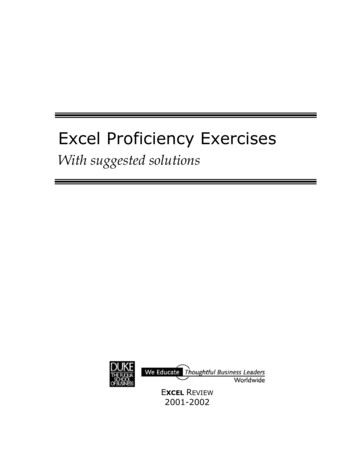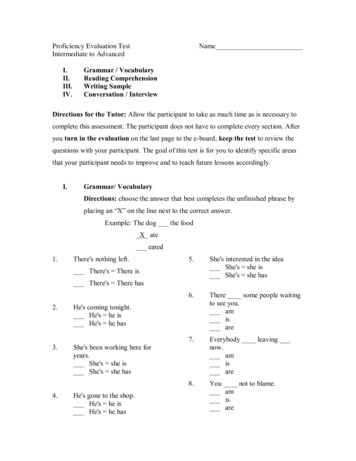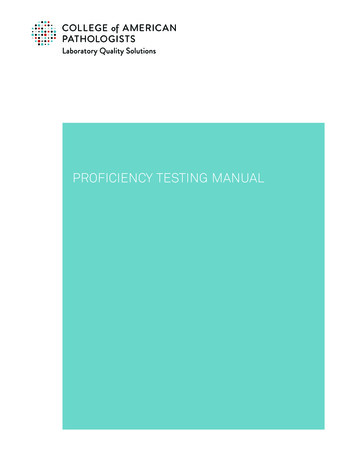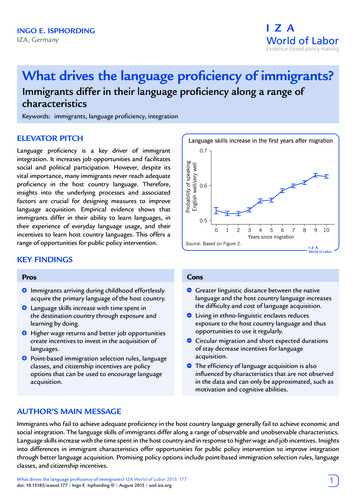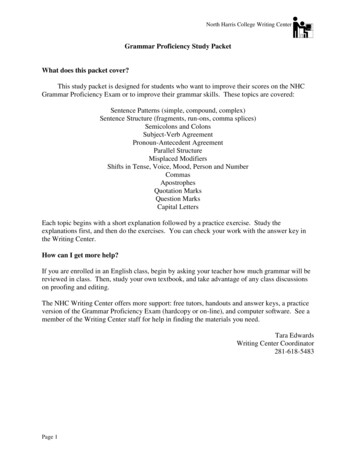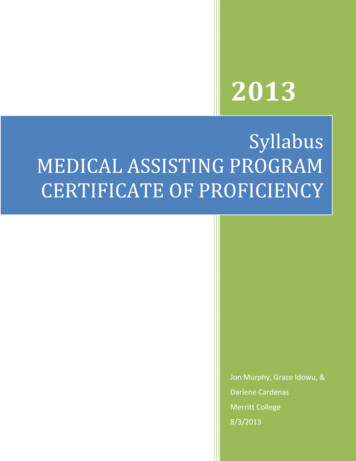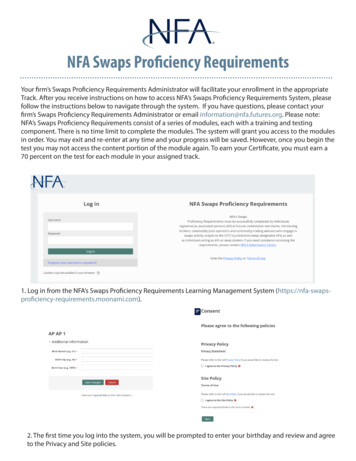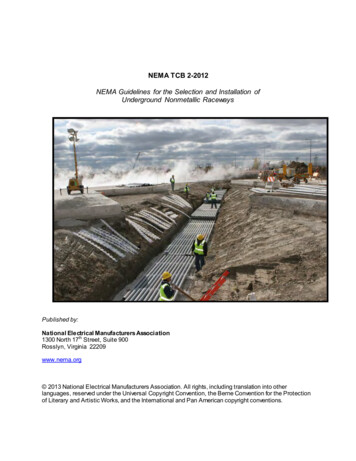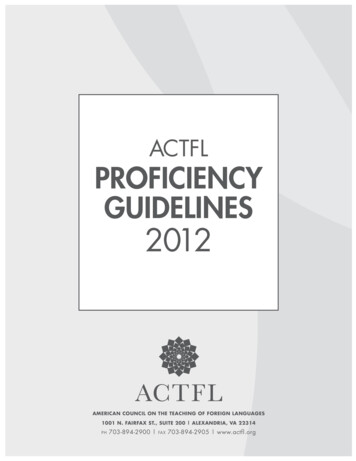
Transcription
ACTFLPROFICIENCYGUIDELINES2012AMERICAN COUNCIL ON THE TEACHING OF FOREIGN LANGUAGES1001 N. FAIRFAX ST., SUITE 200 ALEXANDRIA, VA 22314ph703-894-2900 fax703-894-2905 www.actfl.org1 ACTFL PROFICIENCY GUIDELINES 2012 ACTFL, INC., 2012
ACKNOWLEDGMENTSACTFL is deeply indebted to the many individuals who contributed to the previous editions of the Proficiency Guidelines.In addition, ACTFL wishes to acknowledge the principal authors and editors of this 3rd Edition of the Proficiency Guidelines:Elvira Swender, Daniel J. Conrad, and Robert Vicars; and the invaluable contributions of the project consultants: Mahdi Alosh,Karen Breiner-Sanders, Ray T. Clifford, Helen Hamlyn, David Hiple, Judith Liskin-Gasparro, Pardee Lowe, Jr., CynthiaMartin, Karl F. Otto, Jr., Benjamin Rifkin, Mildred Rivera-Martinez, and Erwin Tschirner.Finally, ACTFL is most appreciative of the comments and feedback from the many members of the profession who contributedgenerously of their time and expertise in reviewing earlier drafts of this document.The ACTFL Proficiency Guidelines 2012 may be used for non-profit, educational purposes only, provided that they arereproduced in their entirety, with no alterations, and with credit to ACTFL.2 ACTFL PROFICIENCY GUIDELINES 2012 ACTFL, INC., 2012
General Prefaceto the ACTFL Proficiency Guidelines 2012The ACTFL Proficiency Guidelines are descriptions of what individuals can do with language in termsof speaking, writing, listening, and reading in real-world situations in a spontaneous and non-rehearsedcontext. For each skill, these guidelines identify five major levels of proficiency: Distinguished, Superior,Advanced, Intermediate, and Novice. The major levels Advanced, Intermediate, and Novice are subdividedinto High, Mid, and Low sublevels. The levels of the ACTFL Guidelines describe the continuum ofproficiency from that of the highly articulate, well-educated language user to a level of little or nofunctional ability.These Guidelines present the levels of proficiency as ranges, and describe what an individual can andcannot do with language at each level, regardless of where, when, or how the language was acquired.Together these levels form a hierarchy in which each level subsumes all lower levels. The Guidelines are notbased on any particular theory, pedagogical method, or educational curriculum. They neither describe howan individual learns a language nor prescribe how an individual should learn a language, and they shouldnot be used for such purposes. They are an instrument for the evaluation of functional language ability.The ACTFL Proficiency Guidelines were first published in 1986 as an adaptation for the academiccommunity of the U.S. Government’s Interagency Language Roundtable (ILR) Skill Level Descriptions.This third edition of the ACTFL Proficiency Guidelines includes the first revisions of Listening andReading since their original publication in 1986, and a second revision of the ACTFL Speaking andWriting Guidelines, which were revised to reflect real-world assessment needs in 1999 and 2001 respectively.New for the 2012 edition are the addition of the major level of Distinguished to the Speaking and WritingGuidelines, the division of the Advanced level into the three sublevels of High, Mid, and Low for theListening and Reading Guidelines, and the addition of a general level description at the Advanced,Intermediate, and Novice levels for all skills.Another new feature of the 2012 Guidelines is their publication online, supported with glossed terminologyand annotated, multimedia samples of performance at each level for Speaking and Writing, and examplesof oral and written texts and tasks associated with each level for Reading and Listening.The direct application of the ACTFL Proficiency Guidelines is for the evaluation of functional languageability. The Guidelines are intended to be used for global assessment in academic and workplace settings.However, the Guidelines do have instructional implications. The ACTFL Proficiency Guidelines underliethe development of the ACTFL Performance Guidelines for K-12 Learners (1998) and are used inconjunction with the National Standards for Foreign Language Learning (1996, 1998, 2006) to describe howwell students meet content standards. For the past 25 years, the ACTFL Guidelines have had an increasinglyprofound impact on language teaching and learning in the United States.3 ACTFL PROFICIENCY GUIDELINES 2012 ACTFL, INC., 2012
ACTFLPROFICIENCYGUIDELINES2012– SPEAKINGPrefaceThe ACTFL Proficiency Guidelines 2012 – Speakingdescribe five major levels of proficiency: Distinguished, Superior,Advanced, Intermediate, and Novice. The description of each major level is representative of a specific range of abilities. Togetherthese levels form a hierarchy in which each level subsumes all lowerlevels. The major levels Advanced, Intermediate, and Novice aredivided into High, Mid, and Low sublevels.The Guidelines describe the tasks that speakers can handle at eachlevel, as well as the content, context, accuracy, and discourse typesassociated with tasks at each level. They also present the limits thatspeakers encounter when attempting to function at the next higher major level.These Guidelines can be used to evaluate speech that is either Interpersonal (interactive, two-way communication) orPresentational (one-way, non-interactive).The written descriptions of speaking proficiency are accompanied online by speech samples illustrating the featuresof each major level.The ACTFL Proficiency Guidelines 2012 – Speaking may be used for non-profit, educational purposes only, provided that they are reproduced in their entirety, with no alterations, and with credit to ACTFL.DISTINGUISHEDSpeakers at the Distinguished level are able to use language skillfully, and with accuracy, efficiency, and effectiveness. They areeducated and articulate users of the language. They can reflect on a wide range of global issues and highly abstract concepts ina culturally appropriate manner. Distinguished-level speakers can use persuasive and hypothetical discourse for representationalpurposes, allowing them to advocate a point of view that is not necessarily their own. They can tailor language to a variety of audiences by adapting their speech and register in ways that are culturally authentic.Speakers at the Distinguished level produce highly sophisticated and tightly organized extended discourse. At the same time, theycan speak succinctly, often using cultural and historical references to allow them to say less and mean more. At this level, oraldiscourse typically resembles written discourse.A non-native accent, a lack of a native-like economy of expression, a limited control of deeply embedded cultural references, and/oran occasional isolated language error may still be present at this level.4 ACTFL PROFICIENCY GUIDELINES 2012 ACTFL, INC., 2012
ACTFL Proficiency Guidelines 2012– SPEAKINGSUPERIORSpeakers at the Superior level are able to communicate with accuracy and fluency in order to participate fully and effectively inconversations on a variety of topics in formal and informal settings from both concrete and abstract perspectives. They discusstheir interests and special fields of competence, explain complex matters in detail, and provide lengthy and coherent narrations, allwith ease, fluency, and accuracy. They present their opinions on a number of issues of interest to them, such as social and politicalissues, and provide structured arguments to support these opinions. They are able to construct and develop hypotheses to explorealternative possibilities.When appropriate, these speakers use extended discourse without unnaturally lengthy hesitation to make their point, even when engaged in abstract elaborations. Such discourse, while coherent, may still be influenced by language patterns other than those of thetarget language. Superior-level speakers employ a variety of interactive and discourse strategies, such as turn-taking and separatingmain ideas from supporting information through the use of syntactic, lexical, and phonetic devices.Speakers at the Superior level demonstrate no pattern of error in the use of basic structures, although they may make sporadic errors, particularly in low-frequency structures and in complex high-frequency structures. Such errors, if they do occur, do not distract the native interlocutoror interfere with commu nication.ADVANCEDSpeakers at the Advanced level engage in conversation in a clearly participatory manner in order to communicate information on autobiographical topics, as well as topics of community, national, or international interest. The topics are handled concretely by meansof narration and description in the major times frames of past, present, and future. These speakers can also deal with a social situation with an unexpected complication. The language of Advanced-level speakers is abundant, the oral paragraph being the measureof Advanced-level length and discourse. Advanced-level speakers have sufficient control of basic structures and generic vocabularyto be understood by native speakers of the language, including those unaccustomed to non-native speech.Advanced HighSpeakers at the Advanced High sublevel perform all Advanced-level tasks with linguistic ease, confidence, and competence. They are consistently able to explain in detail and narrate fully and accurately in all time frames. In addition, Advanced High speakers handle the tasks pertaining to the Superior level but cannot sustain performance at that level acrossa variety of topics. They may provide a structured argument to support their opinions, and they may construct hypotheses,but patterns of error appear. They can discuss some topics abstractly, especially those relating to their particular interestsand special fields of expertise, but in general, they are more comfortable discussing a variety of topics concretely.Advanced High speakers may demonstrate a well-developed ability to compensate for an imperfect grasp of some forms or forlimitations in vocabulary by the confident use of communicative strategies, such as paraphrasing, circumlocution, and illustration. They use precise vocabulary and intonation to express meaning and often show great fluency and ease of speech. However, when called on to perform the complex tasks associated with the Superior level over a variety of topics, their languagewill at times break down or prove inadequate, or they may avoid the task altogether, for example, by resorting to simplificationthrough the use of description or narration in place of argument or hypothesis.5 ACTFL PROFICIENCY GUIDELINES 2012 ACTFL, INC., 2012
ACTFL Proficiency Guidelines 2012– SPEAKINGAdvanced MidSpeakers at the Advanced Mid sublevel are able to handle with ease and confidence a large number of communicativetasks. They participate actively in most informal and some formal exchanges on a variety of concrete topics relating towork, school, home, and leisure activities, as well as topics relating to events of current, public, and personal interest orindividual relevance.Advanced Mid speakers demonstrate the ability to narrate and describe in the major time frames of past, present, andfuture by providing a full account, with good control of aspect. Narration and description tend to be combined and interwoven to relate relevant and supporting facts in connected, paragraph-length discourse.Advanced Mid speakers can handle successfully and with relative ease the linguistic challenges presented by a complication or unexpected turn of events that occurs within the context of a routine situation or communicative task with which theyare otherwise familiar. Communicative strategies such as circumlocution or rephrasing are often employed for this purpose.The speech of Advanced Mid speakers performing Advanced-level tasks is marked by substantial flow. Their vocabulary isfairly extensive although primarily generic in nature, except in the case of a particular area of specialization or interest. Theirdiscourse may still reflect the oral paragraph structure of their own language rather than that of the target language.Advanced Mid speakers contribute to conversations on a variety of familiar topics, dealt with concretely, with much accuracy, clarity and precision, and they convey their intended message without misrepresentation or confusion. They arereadily understood by native speakers unaccustomed to dealing with non-natives. When called on to perform functions orhandle topics associated with the Superior level, the quality and/or quantity of their speech will generally decline.Advanced LowSpeakers at the Advanced Low sublevel are able to handle a variety of communicative tasks. They are able to participate inmost informal and some formal conversations on topics related to school, home, and leisure activities. They can also speakabout some topics related to employment, current events, and matters of public and community interest.Advanced Low speakers demonstrate the ability to narrate and describe in the major time frames of past, present, and future in paragraph-length discourse with some control of aspect. In these narrations and descriptions, Advanced Low speakers combine and link sentences into connected discourse of paragraph length, although these narrations and descriptionstend to be handled separately rather than interwoven. They can handle appropriately the essential linguistic challengespresented by a complication or an unexpected turn of events.Responses produced by Advanced Low speakers are typically not longer than a single paragraph. The speaker’s dominant language may be evident in the use of false cognates, literal translations, or the oral paragraph structure of that language. At timestheir discourse may be minimal for the level, marked by an irregular flow, and containing noticeable self-correction. More generally, the performance of Advanced Low s
Advanced-level speakers have sufficient control of basic structures and generic vocabulary to be understood by native speakers of the language, including those unaccustomed to non-native speech. Advanced High Speakers at the Advanced High sublevel perform all Advanced-level tasks with linguistic ease, confidence, and compe-tence. They are consistently able to explain in detail and

